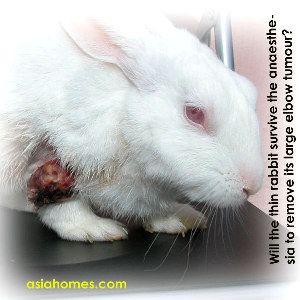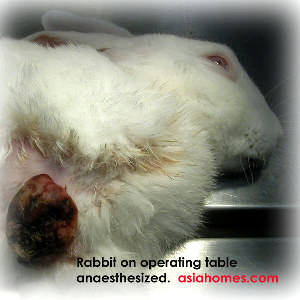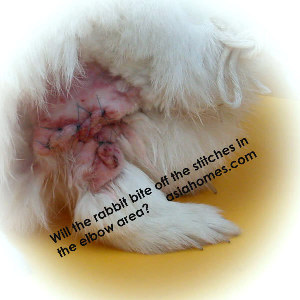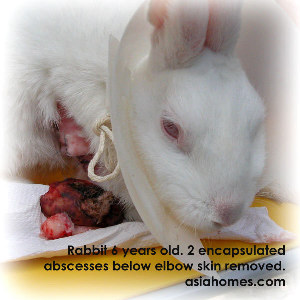|
CASE 1. Did the deadly Meloidosis bacteria infect
this rabbit?
"Put the rabbit to sleep." Mr Tan said in an authoritative
tone as he fished out a white rabbit from a pink plastic
carrier cage. "It has cancer of the mouth." His
10-year old daughter was with him and had no choice.
 A big black globular lump of 3 cm in diameter, hard as
a pebble on the shores of the Pasir Ris Beach protruded from
the commissures of the left side of its mouth. A big black globular lump of 3 cm in diameter, hard as
a pebble on the shores of the Pasir Ris Beach protruded from
the commissures of the left side of its mouth.
Yellow pus could be seen on the inner side. The outer area
was enveloped by a big hard skin. There was no need to
talk much as the pragmatic client had decided that it would
be too costly to operate. A brand new replacement rabbit
would cost less.
"Could it have developed from an original wound inside the
mouth or the root of the tooth?" I asked the senior
veterinary surgeon. "Was this an infected skin tumour
or an encapsulated gangrenous abscess? The blood
supply could have been cut off, resulting in the blackened
skin discoloration. Or was it a potent bacteria able
to kill all tissues under the skin, resulting in a black
lump of necrotic (dead) tissue under the skin?"
 Nature
sometimes present the veterinarian challenging problems to
solve. Nature
sometimes present the veterinarian challenging problems to
solve.
"Rabbits are well known to have hard abscesses. This looked
like an encapsulated abscess commonly found in the internal
organ of sheep and caused by one of the deadliest bacteria
in the world," the senior vet replied. "The bacteria
is said to be present in the soil and causes Meloidosis in
sheep and as well as killing people."
As a new graduate, it was good to have a senior to consult.
He continued to warn me, "This bacteria forms cheesy or
thick pus-like abscess in the internal organs of sheep and
is well documented in sheep medicine.
"Do rabbits get infected too?" I asked.
"No reported cases," the senior vet replied. "The rabbit
could be infected by a lethal tissue destroying
bacteria like Group A Streptococcus (GAS) bacteria which
eats flesh and had got in from the tooth root?"
In that case, should the vets mess around with this
dangerous bacteria?
Could the lump be removed by cutting it off? Would the
rabbit then die? Was it wise to cut it off? How
much it would cost? A replacement white rabbit cost
around $20.00 and the veterinary treatment might cost ten
new rabbits and more if there was surgery and anaesthesia.
"You can't save all the sick rabbits in this world," the
senior said.
"Maybe, just this one. He's a young rabbit". It was
not the age but the cost of treatment that affects the
profitability of a private practice. Should not all private
business look at cutting down expenses as the cost of living
and rentals in Singapore inevitably become more expensive as
it progresses to being a
 developed
country. developed
country.
How much was the cost of compassion towards one rabbit?
It was not much but if the veterinarian saves all such
cases, it could be a big amount.
An antibiotic injection was given and the rabbit was placed
under observation. The rabbit was eating well but
avoided the hard rabbit feed pellets. Water melon was
greatly appreciated. Twelve days later, he stopped
eating much. He began to lose weight. He would die soon as
he lost a lot of weight and was not eating or drinking.
 In
this life and death situation, should I operate?
Should the rabbit be put out of suffering with one lethal
injection? The jaw lump must have been very painful.
His life was in a veterinarian's hands. Would he live
if he was operated? Would his suffering be
prolonged? In
this life and death situation, should I operate?
Should the rabbit be put out of suffering with one lethal
injection? The jaw lump must have been very painful.
His life was in a veterinarian's hands. Would he live
if he was operated? Would his suffering be
prolonged?
A pain killer was given. The lump came off the jaw
area and exposed a big hole. There was no need to put it
under anaesthesia. Young healthy creatures have excellent
healing powers. The wound closed within seven days.
Within twenty days, there was a small hole and new tissue
had bridged the gaping hole. The rabbit had an excellent
appetite and put on much weight.
 It
was fortunate that no nasty scars could be seen. It would be
too expensive to send the necrotic tissue for laboratory
analysis. The bacteria causing dead tissue under the
skin would most likely be the GAS or Clostridium bacteria
entering the lower cheek from the tooth root. These flesh
eating micro organisms thrive well and multiply deep in the
skin as they dislike oxygen. They are called anaerobic
bacteria as they cannot survive in the presence of oxygen.
In human medicine, the treatment of necrotising fasciitis
would be a combination of intensive antibiotic injections,
surgery to remove the dead tissue, fluid therapy and pure
oxygen. It
was fortunate that no nasty scars could be seen. It would be
too expensive to send the necrotic tissue for laboratory
analysis. The bacteria causing dead tissue under the
skin would most likely be the GAS or Clostridium bacteria
entering the lower cheek from the tooth root. These flesh
eating micro organisms thrive well and multiply deep in the
skin as they dislike oxygen. They are called anaerobic
bacteria as they cannot survive in the presence of oxygen.
In human medicine, the treatment of necrotising fasciitis
would be a combination of intensive antibiotic injections,
surgery to remove the dead tissue, fluid therapy and pure
oxygen.
Note for Biology students: Oxygen
therapy is used in human medicine to treat
necrotising fasciitis.
In Singapore, the Hyperbaric Medicine Branch of the Republic
of Singapore Navy's Naval Medicine and Hyperbaric Centre
used to be the only place to get such treatment. Its
primary role is to treat navy divers who suffer from
decompression illness. It treats many recreational divers
and other conditions which benefit from oxygen therapy such
as carbon monoxide poisoning, gas gangrene in wounds
infected by anaerobic bacteria, diabetic ulcers, compromised
skin grafts, radiation tissue damage for cancer patients and
burns. In 2001, the Tan Tock Seng Hospital will start
a hyperbaric medicine centre.
Hyperbaric oxygen acts as a drug as some types of bacteria
such as those eating flesh, will die if exposed to oxygen.
The patient is given 100% oxygen at 2 to 3 times the normal
atmospheric pressure (sea level pressure) while kept in an
enclosed oxygen pressure. Oxygen is at a low level in
flesh eating tissues and is needed by the cells to sustain
life. The oxygen is more easily absorbed by the cells
deprived of oxygen when the patient is put under high
atmospheric pressure.
Note:
Cells die in 2 different ways.
1. Apoptosis.
Programmed cell death. The cell is gradually
disassembled from within, then engulfed and digested by the
white blood cells. An example is an aging cell.
2. Necrosis. A
frenzied form of killing the cell, releasing cell's total
contents including toxic chemicals and enzymes and damaging
surrounding cells, causing inflammation manifested by
redness and swelling of the tissue cells. An example
is bacterial infection of the cell.
CASE 2.
Will
the rabbit die on the operating table?
"What is your advice?" Mr
Loo asked.
His wife's rabbit had a huge black elbow and there
was another smaller one under the skin. I had given
the rabbit an anti-inflammatory injection ten days ago and
the growth had dried up. The skin around the growth
looked the healthy pink colour and was not weepy. The
rabbit had stopped licking it but it was a matter of time
when the rabbit had to lick it to relieve itself of the
persistent pain and redness.
"Much depends on how deep your pocket is," I replied. "This
rabbit is very thin and it may just die on the operating
table to remove its lump or a few days after the surgery."
In that case Mr Loo would have paid the $200 operation
bills and get a dead rabbit.
Rabbits are inexpensive pets. Therefore, the pragmatic
owners think in terms of replacement costs as ten times
cheaper than veterinary costs.
"How long does a rabbit live?" Mr Loo asked. That was
a question I did not anticipate. If the 6-year-old rabbit
was at the end of its life span, then it would not be worth
the money to treat it.
"8 - 12 years." I replied. "A healthy one live longer."
If this rabbit survived the operation, it could have 2 - 6
years of life. Would 2 years of quiet companionship be worth
the $200?
Rabbits are seldom demonstrative in their emotions, unlike
dogs. I guessed Mr Loo was not bonded to it. If the
veterinary fees were lower than the replacement fee, he
would go for the risk of surgery.
So, should it be euthanased? I had not expected to see
Mr Loo after the first visit as many rabbit owners are
pragmatic and seldom give such cases a second chance to
live.
"You can save on veterinary bills by taking the rabbit home
after surgery," I suggested. "I prefer to observe it for
another 3 days. If the stitches are not chewed of, the
wound will heal very well in 10 - 14 days." The cost
of warding it would be $10 per day.
It was a hard economic decision. Mr Loo said, "My wife
wanted the rabbit operated." So, it was a sentimental
decision. Now, should I risk operating the rabbit? Would
there be sufficient skin to stitch up the big hole after
removal of the growth? Would the rabbit chew off the
stitches and make a bigger hole? And more costs and
trauma to the wife?
The rabbit was operated and as at day 2, it was behaving
itself and eating.
 |
 |
|
The 6-year-old
rabbit now has a huge itchy skin growth. It lost a lot
of weight and may die on the operating table. Should
the owner put it to sleep or spend $200 to operate? A
new rabbit costs 10% of the veterinary fees |
 |
 |
|
The rabbit had 2
encapsulated abscesses under the elbow skin and
several small ones. Dogs do lick skin growths too and
it is always LESS costly to consult your vet earlier
than much later. |
|
 TOA
PAYOH VETS
TOA
PAYOH VETS TOA
PAYOH VETS
TOA
PAYOH VETS